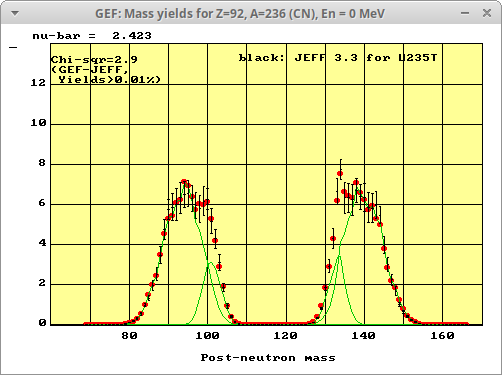GEF 2019/1.1
General
description of fission observables. Released February 4, 2019.
Update: February 11, 2019 (minor revisions).
Update: February 17, 2019 (multi-chance fission supported for energy distribution from file).
Update: April 15, 2019 (output of fission probabilities for E*-distribution from file with multi-chance fission).
Update: May 5, 2019 (extended output of list-mode data).
Last update: June 6, 2019 (revised list-mode output, excitation energy of higher-chance fission revised).
Short characterisation of GEF 2019/1.1:
The parameters of GEF were re-adjusted, using some very accurate mass
yields measured at LOHENGRIN and sets of independent yields from JEFF
3.3. An apparent influence of the N=50 shell on the charge polarization
was introduced. The calculations of the fission probability and of the
gamma spectrum were revised. Calculations outside the recommended
validity range of GEF (in A, Z or E* of the fissioning system) have
been made possible with a warning.
Properties of GEF 2019/1.1:
GEF 2019/1.1 gives a good
description of different kind of fission data for a large variety of
systems. Tests are still going on. Therefore, some minor modification may still be applied.
Very
accurately measured fission yields of specific systems are better
reproduced with locally adjusted parameters. (See this table for the values of the local parameters.) The adjustment was
performed for different groups of elements, not for individual
fissioning systems. (It is assumed that this adjustement refers to weak
shells, which could not be taken into account in the standard formalism
of GEF.) If most realistic results, also of other fission quantitites,
are demanded, it is recommended to use locally adjusted parameters.
The
mass distribution from GEF can be compared with empirical data from the
ENDF/B-VII, JEFF 3.1.1, JEFF 3.3 evaluations or from experiments at
LOHENGRIN in a plot (see example below), if available. This table lists the data that are stored in GEF. (In the moment, the Windows version of GEF has only access to ENDF/B-VII and JEFF 3.3.)
The mass distribution of 235U(nth,f) from GEF-2019/1.1 (red
points) in
comparison with the JEFF 3.3 evalution (black symbols with error
bars). The calculated contributions from different
fission channels are traced in green. 10 million events have been
calculated. (If the figure is not shown, pllease use this link.)
An extended version of GEF-2019/1.1
that
includes delayed processes (output of delayed-neutron multiplicities,
delayed-neutron emitters, cumulative fission-fragment yields in ENDF
format) is available on demand. It provides also an
option for producing random files of fission-fragment yields in ENDF
format.
We
are happy about any feed-back (mail to
schmidt-erzhausen<at>t_online.de). This helps to correct errors,
to improve the quality of the model and to better respond to the needs
and preferences of the users.
Use of the GEF code is subject to the GNU GENERAL PUBLIC LICENSE
agreement that you find here: <License>.
Stand-alone version (Monte-Carlo method)
The
stand-alone version of the GEF code is written in FreeBASIC (a). The
FreeBASIC compiler produces binary code from the same source on Windows
(b) and on Linux. The executable uses the C library. For
the Windows
version, a GUI is provided, written in JustBasic (c). The Windows
version runs also on Linux with Wine (d). The Windows version
runs also on OS X (e)
with Wine (d).
a) FreeBASIC is available from http://www.freebasic.net/ with no
cost.
b) Windows is either a registered trademark or a trademark of Microsoft
Corporation in the United States and/or other countries.
c) JustBasic is available from http://www.justbasic.com/ with no cost.
d) Wine is a windows compatibility layer for Linux and Mac OS X
(http://www.winehq.org/).
e) OS X is a trademark of Apple Inc., registered in the U.S. and other
countries.
Quick start on Windows:
- Download the binaries
(that includes some additional files).
- Start GEF.bat in a
command window.
- Fill in the input mask of the graphical user interface and start
the calculation.
- Output is written to file \out\...
.dat.
Quick start on Linux:
- Download the binaries.
- Make sure that the binary file GEF is executable.
- Enter ./GEF in a command
window.
- Answer the input dialogue.
- Output is written to file
/out/... .dat.
Windows version
Input mask of the graphical
user interface:
For Windows and Linux
Complete
package
Documentation
Readme file
(Technical information, list of relevant publications)
JEFF-Report
24, part I
(Comprehensive documentation of the GEF model.)
JEFF-Report
24, part II
(Technical information on the GEF code.)
Source (for Windows and Linux)
Source
files
Data
Input files for extended input options
Distribution of entrance energies (example)
List of input parameters (example)
See Readme file
for more detailed information.
Output
Data tables in XML-assisted format (example)
List-mode file (example)
(short sample of most complete event list)
Raw data for the multi-variate distribution of fission-fragment yields
from calculations with perturbed parameters (example)
See Readme file
for more detailed information.
You
may consider using the Windows version of GEF on Linux with Wine in
order to profit from the more comfortable input handling offered by the
graphical user interface. This option may also solve problems of
missing libraries under Linux.
Subroutine (Folding method)
The subroutine aims for being used
in combination with other nuclear-reaction codes. For a given
fissioning nucleus with excitation energy E* and angular momentum I
it calculates complete distributions of a number of fission observables
before emission of prompt neutrons and prompt gamma radiation with the
GEF model.
Documentation
Technical description of the subroutine
FreeBASIC version
In preparation
FORTRAN version
In preparation


